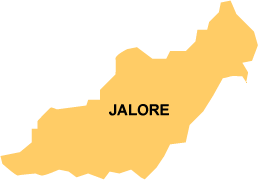Mahila Mandal Barmer Agor
Jalore District
 Jalore district is surrounded by Barmer on its north-west, Sirohi on its south-east, Pali on its north-east and Banaskantha district of Gujarat on the south-western part of Rajasthan. Jalore is situated on the southern edge of the vast sandy plain of Marwar. It is a typical small town of Rajasthan with the serene and unruffled surroundings. The city is also known as the Granite City. Main rocks found in the area are Malani, Jwalamukhi and Jalore granite.
Jalore district is surrounded by Barmer on its north-west, Sirohi on its south-east, Pali on its north-east and Banaskantha district of Gujarat on the south-western part of Rajasthan. Jalore is situated on the southern edge of the vast sandy plain of Marwar. It is a typical small town of Rajasthan with the serene and unruffled surroundings. The city is also known as the Granite City. Main rocks found in the area are Malani, Jwalamukhi and Jalore granite.
Socio-Economic Status
Jalore has three major towns, Jalore, Bhinmal and Sanchore. Major castes of the area are Rajpurohit, Chaudhury and Jain. 10 percent of the total population of the district belongs to SCs and STs i.e. Jogi, Saansi, Nutand others. Thus a large number of the population depends upon the agriculture, while rest of the population is involved in labour, business and a very small number in government jobs. The vulnerable people have no other work than taxi and truck driving, labour work in the granite mines and building construction. Few of the persons are deeply involved in alcohol making (legally or illegally).
Some of the major causes of atrocities and other offences against dalits in Jalore district are related to issues of land and property, access to water, wage payments, indebtedness and bonded or forced labour. Issues of human dignity, including compulsion to perform distasteful tasks traditionally forced on dalits, and molestation and exploitation of dalit women are involved. Caste related tension exacerbated by economic factors, mainly contributes to violence in the region.
So it can be said that Jalore is not much developed socially due to its low literacy rate of 46.5 out of which female literacy is only 27.8 out of the total female population of 711060. It is a male dominating society and women have only right to work in the crop fields but not to speak and debate on any matter. Women do not have access to family property and they do not have any control over household expenditure although their support to family economy through working in the field is equal to men. The position of rural women is downtrodden with the low literacy of 25 percent. The veil system is found everywhere and generally women are not allowed to go out of house while males migrate to the other states and cities in search of employment or business and get infected with AIDS. Dependence on men increases women's legal, economic and social vulnerability, leading to sexual vulnerability.
Livelihood
The economy of Jalore district is characterised by diversity in terms of livelihood sources and low levels of income. Mining and quarrying make up the primary sector for employment in this area. Small artisans are engaged in traditional crafts. Agriculture and animal husbandry are the principal sources of livelihood in rural areas of Jalore district. The people are mainly small farmers who grow moong, guar, and mustard during the four months of monsoon. The scanty rain and dry climatic conditions are predominant throughout the district. The poor people mainly from deprived community are engaged in labour work at district and block level. Poverty haunts the villages like a bad omen that can never be warded off.
Women are paid lower wages than the male workers and often well below the minimum wage. The poor working conditions persist due to an absence of any collective bargaining or union formation while the mine owners reap substantial benefits with high profits and few liabilities.
Problems in access to healthcare in this area are related to the harsh terrain and lack of efficient communication systems. All these dimensions of human development need to be improved. Jalore District comes at the lower end for Human Development Indicator values in Rajasthan.
In Jalore, district development programs have not met with uniform success. Renewed commitment of human and financial resources is required to improve the status of development in Jalore District.
The gender development index illustrates the persistence of gender inequalities in Jalore. It is, therefore, necessary to involve the local community and NGOs to join the state government in evolving suitable policies and initiatives that would redress this situation.
Given the wide variations in the geographical and social structures of the district no one-dimensional measure of growth, such as income, can be adequate.
District at a glance
Indicators of Human Resources
| Population | 1,448,940 |
| Density of population (sq km) | 136 |
| Percentage of literacy | 46.51 |
| Total working population | 31.05 |
Percentage distribution of work force
| Cultivators | 68.72 % |
| Agricultural labourers | 13.63 % |
| Servicing and repairs | 3.05 % |
| Other workers | 18.51 % |
Health Statistics of Jalore District
| Sl. | Nature of Facility | In Figures |
| 1 | Number of functional bed in the District Hospital | 170 |
| 2 | Number of civil/ sub-divisional hospitals | 2 |
| 3 | Number of dispensary | 2 |
| 4 | Mother and child welfare centres (MCWC) | 4 |
| 5 | Number of primary health centres (PHCs) | 56 |
| 6 | Number of sub-centres (SC) | 299 |
| 7 | Rural family welfare centres (FWCs) | 7 |